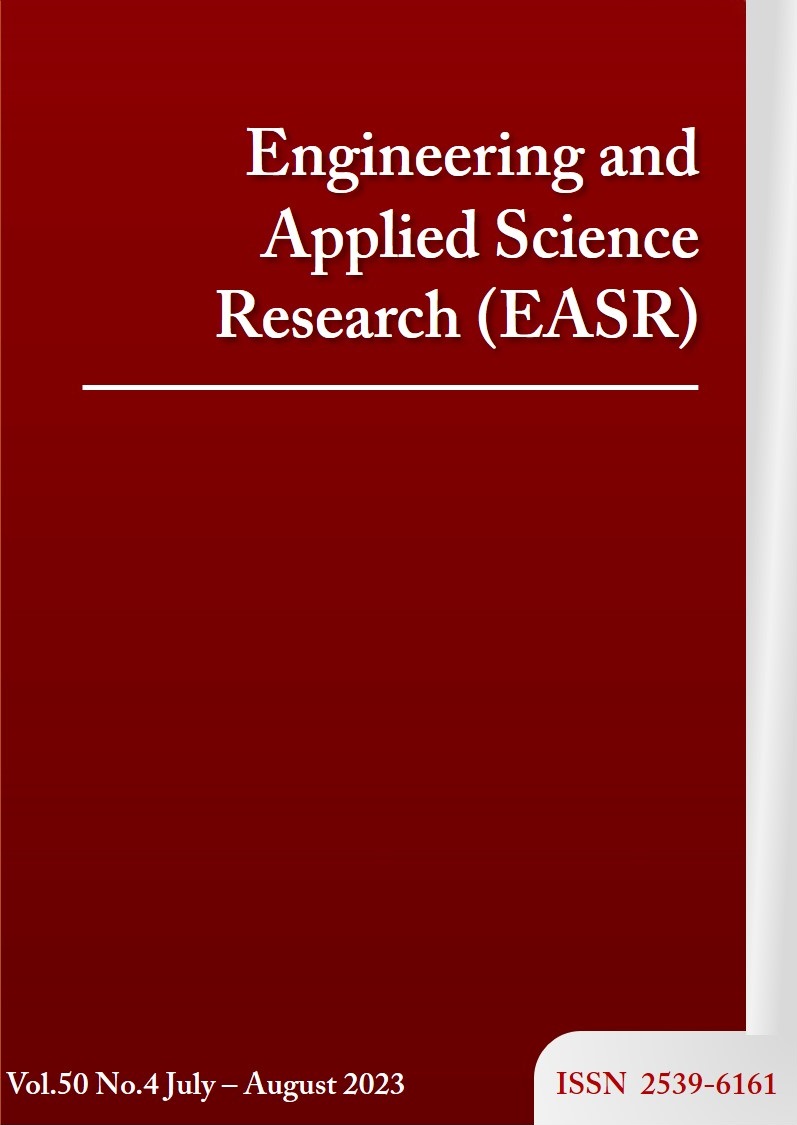Hexadecyltrimethylammonium-modified fly-ash zeolite for sulfate removal in treated coal-fired power plant effluent
Main Article Content
Abstract
This research was conducted primarily to examine sulfate ion (SO42-) removal from aqueous solutions using zeolite NaP1 surface modified with hexadecyltrimethylammonium (HDTMA), or so-called MZ-HDTMA. To be suitable for SO42- removal conditions, the synthetic conditions of MZ-HDTMA were optimized utilizing a Box-Behnken design approach. Experiments were conducted considering three factors that influence synthesis, including the amount of HDTMA cationic surfactant (3.33-6.67 wt%), mixing time (0.5-2 h), and drying temperature (50-80°C). The zeolite NaP1 synthesized from fly ash and MZ-HDTMA were characterized to compare their characteristics using techniques including point of zero charge (pHpzc), scanning electron microscopy (SEM), and x-ray diffraction (XRD). The results from SO42- removal showed that the most significant effect was the weight percentage of HDTMA. Adsorption kinetic studies revealed that modified zeolite had a SO42- removal amount of 8.913 mg/g at equilibrium time and better fitted the pseudo-second-order model (R2 = 0.99). This study established that more than 80% of the SO42- in the aqueous solution was removed.
Article Details

This work is licensed under a Creative Commons Attribution-NonCommercial-NoDerivatives 4.0 International License.
This work is licensed under a Creative Commons Attribution-NonCommercial-NoDerivatives 4.0 International License.
References
Greenwood NN, Earnshaw A. Chemistry of the Elements. New York: Pergamon Press; 1984.
US EPA. Sulfate in Drinking Water [Internet]. 2012 [cited 2022 Oct 23]. Available form: https://archive.epa.gov/water/ archive/web/html/sulfate.html.
Lens PNL, Visser A, Janssen AJH, Hulshoff Pol LW, Lettinga G. Critical reviews in environmental science and technology biotechnological treatment of sulfate-rich wastewaters biotechnological treatment of sulfate-rich wastewaters. Crit Rev Environ Sci Technol. 1998;28(1):41-88.
Zhang J, Tang L, Zhang H, Yang Y, Mao Z. A novel and cleaner technological process of extracting l-glutamic acid from fermentation broth by two-stage crystallization. J Clean Prod. 2012;20(1):137-44.
Sadeghalvad B, Khorshidi N, Azadmehr A, Sillanpää M. Sorption, mechanism, and behavior of sulfate on various adsorbents: a critical review. Chemosphere. 2021;263:128064.
Runtti H, Tuomikoski S, Kangas T, Kuokkanen T, Rämö J, Lassi U. Sulphate removal from water by carbon residue from biomass gasification: Effect of chemical modification methods on sulphate removal efficiency. BioRes. 2016;11(2):3136-52.
Runtti H, Tynjälä P, Tuomikoski S, Kangas T, Hu T, Rämö J, et al. Utilisation of barium-modified analcime in sulphate removal: isotherms, kinetics and thermodynamics studies. J Water Process Eng. 2017;16:319-28.
Zheng Q, Zhang Y, Li Y, Zhang Z, Wu A, Shi H. Adsorption of sulfate from acid mine drainage in Northwestern China using Malan loess. Arab J Geosci. 2019;12(11):348.
Sadeghalvad B, Azadmehr A, Hezarkhani A. A new approach to improve sulfate uptake from contaminated aqueous solution: metal layered double hydroxides functionalized metasomatic rock. 2019;54(4):447-66.
Phanthasri J, Grisdanurak N, Khamdahsag P, Wantala K, Khunphonoi R, Wannapaiboon S, et al. Role of zeolite-supported nanoscale zero-valent iron in selenate removal. Water Air Soil Pollut. 2020;231(5):199.
Córdoba P. Status of flue gas desulphurisation (FGD) systems from coal-fired power plants: overview of the physic-chemical control processes of wet limestone FGDs. Fuel. 2015;144:274-86.
Suwannatrai S, Yan DYS, Phanthasri J, Khamdahsag P, Wannapaiboon S, Tanboonchuy V. Oxidation–adsorption of arsenite contaminated water over ceria nanorods. Desalin Water Treat. 2020;200:252-61.
Suwannatrai S, Yan DYS, Khamdahsag P, Tanboonchuy V. Zeolite/Cerium oxide coat-on activated alumina ball for arsenite removal via fixed- bed continuous flow adsorption column. Appl Sci Eng Prog. 2022;15(4):1-10.
Phanthasri J, Yan DYS, Wantala K, Khunphonoi R, Tanboonchuy V. Reduction and adsorption co-processes for selenate removal by zeolite-supported nanoscale zero-valent iron. Eng Applied Sci Res. 2022;49(3):363-72.
Dimas Rivera GL, Martínez Hernández A, Pérez Cabello AF, Rivas Barragán EL, Liñán Montes A, Flores Escamilla GA, et al. Removal of chromate anions and immobilization using surfactant-modified zeolites. J Water Process Eng. 2021;39:101717.
Łach M, Grela A, Pławecka K, Guigou MD, Mikuła J, Komar N, et al. Surface modification of synthetic zeolites with Ca and HDTMA compounds with determination of their phytoavailability and comparison of CEC and AEC parameters. Materials. 2022;15(12):4083.
Noroozi R, Al-Musawi TJ, Kazemian H, Kalhori EM, Zarrabi M. Removal of cyanide using surface-modified Linde Type-A zeolite nanoparticles as an efficient and eco-friendly material. J Water Process Eng. 2018;21:44-51.
Izidoro JDC, Fungaro DA, dos Santos FS, Wang S. Characteristics of Brazilian coal fly ashes and their synthesized zeolites. Fuel Process Technol. 2012;97:38-44.
Szala B, Bajda T, Matusik J, Zięba K, Kijak B. BTX sorption on Na-P1 organo-zeolite as a process controlled by the amount of adsorbed HDTMA. Microporous Mesoporous Mater. 2015;202:115-23.
de Gennaro B. Chapter 3 - Surface modification of zeolites for environmental applications. In: Mercurio M, Sarkar B, Langella A, editors. Modified Clay and Zeolite Nanocomposite Materials: Environmental and Pharmaceutical Applications. Amsterdam: Elsevier Inc; 2018. p. 57-85.
Huang Y, Lee X, Grattieri M, Macazo FC, Cai R, Minteer SD. A sustainable adsorbent for phosphate removal: modifying multi-walled carbon nanotubes with chitosan. J Mater Sci. 2018;53(17):12641-9.



